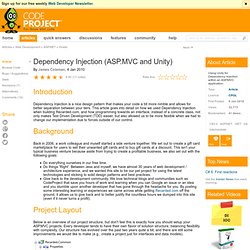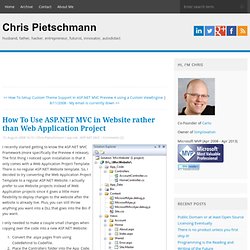

Dependency Injection and Inversion of Control with ASP.NET MVC. As you delve more into ASP.NET MVC you start to come across a whole new way of doing things that Web Forms development didn't really expose you to.

Inversion of Control (IoC) and Dependency Injection (DI) are two phrases that crop up a lot in the MVC space. So what are they all about? And should you care? I should start by stating the IoC and DI are not unique to ASP.NET MVC. They have been around a long time. Just to clear up any initial confusion, yes - the example above is more or less the same code twice. There is no separation of concerns here in that the data access layer is embedded in the Controller. "Oh, but that will never happen to me", you say. When you view Data Access as a "component" of your application, you should also start to see that there are other areas in an application which could be viewed as components. Another problem with the tightly coupled examples is with Unit Testing. Dependency Injection and this: Right. This is a lot better. IoC Containers Summary. Dependency Injection (ASP.MVC and Unity) Introduction Dependency Injection is a nice design pattern that makes your code a bit more nimble and allows for better separation between your tiers.

This article goes into detail on how we used Dependency Injection when building Recarded.com, and how programming towards an interface, instead of a concrete class, not only makes Test Driven Development (TDD) easier, but also allowed us to be more flexible when we had to change our implementation due to forces outside of our control. Background Back in 2006, a work colleague and myself started a side venture together. We set out to create a gift card marketplace for users to sell their unwanted gift cards and to buy gift cards at a discount. Do everything ourselves in our free time. Project Layout Below is an overview of our project structure, but don't feel this is exactly how you should setup your ASP.MVC projects. Recarded.Tests We list this one first because it is the most important. How To Use ASP.NET MVC in Website rather than Web Application Project. I recently started getting to know the ASP.NET MVC Framework (more specifically the Preview 4 release).

The first thing I noticed upon installation is that it only comes with a Web Application Project Template. There is no regular ASP.NET Website template. So, I decided to try converting the Web Application Project Template to a regular ASP.NET Website. I actually prefer to use Website projects instead of Web Application projects since it gives a little more flexibility to deploy changes to the website after the website is already live. Plus, you can still throw anything you want into a DLL that goes into the Bin if you want. I only needed to make a couple small changes when copying over the code into a new ASP.NET Website: Convert the .aspx pages from using CodeBehind to CodeFile.
MVC.